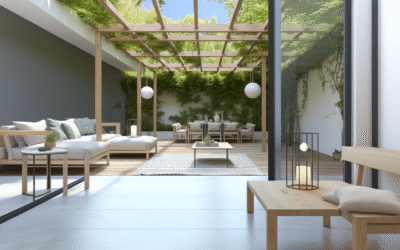
Transform Your Bedroom Into A Serene Sanctuary With These Tips
Your bedroom: it’s more than just a place to sleep, isn’t it? It’s your personal escape, a sanctuary where you can recharge and be yourself. But how many of us actually feel that way about our bedrooms? If yours is more chaotic closet than calming retreat, fear not! With a few clever tweaks, you can create a space that nurtures your well-being and promotes restful sleep. Let’s get started, shall we?
Declutter and Conquer: Setting the Stage for Serenity
Okay, let’s be honest, clutter is the enemy. Piles of clothes, stacks of books, random objects you can’t even remember acquiring—they all contribute to a sense of unease. Think of it this way: A cluttered room equals a cluttered mind. You know what I mean?
Start by ruthlessly purging. Ask yourself: “Do I love it? Do I use it regularly?” If the answer is no to both, it’s gotta go! Donate, sell, or toss – whatever it takes to free up space. Once you’ve decluttered, you can focus on thoughtful organization.
- Under-bed storage: Perfect for stashing away seasonal clothing, extra linens, or anything else you don’t need immediate access to.
- Nightstand organizers: Keep your bedside essentials tidy and within reach – think books, glasses, and a calming aromatherapy diffuser.
- Wall-mounted shelves: A great way to display decorative items without taking up precious floor space. Plus, they give your room a feeling of height.
Don’t underestimate the power of a clean space to lift your spirits and clear your head. You’d be surprised how peaceful you feel just by getting rid of the excess baggage, both literally and figuratively.
Color Me Calm: Selecting a Soothing Palette
Color has a huge impact on our mood. Ever noticed how a brightly colored room can feel energizing, while a dimly lit space feels more relaxing? When it comes to your bedroom, you want to create an atmosphere that promotes tranquility.
Think soft, muted tones. Blues, greens, grays, and gentle lavenders are all excellent choices. These colors evoke feelings of peace, nature, and serenity. But hey, don’t feel limited by these suggestions. The most important thing is to choose colors that you find personally calming. If a pop of vibrant color makes you happy, incorporate it as an accent – maybe a throw pillow or a piece of art. Just don’t go overboard.
Here’s a quick rundown:
- Blues: Associated with calmness, serenity, and stability. Think of a clear sky or a tranquil ocean.
- Greens: Evokes feelings of nature, growth, and harmony. A soft green can be incredibly soothing.
- Grays: A versatile neutral that can create a sense of sophistication and calmness. Just be sure to choose a warm gray to avoid a cold or sterile feeling.
- Lavenders: Promotes relaxation and peace. A light lavender can be incredibly restful.
And speaking of color, don’t forget the power of white! White walls can create a bright, airy feel that enhances the sense of space and tranquility. It’s like hitting the reset button for your senses.
Let There Be (Soft) Light: Mastering Bedroom Illumination
Lighting can make or break a room’s ambiance. Harsh, bright lights are great for task-oriented spaces, but they’re definitely not conducive to relaxation. You want to create a soft, warm glow that encourages your body to wind down.
Layered lighting is key. This means incorporating a variety of light sources to create the perfect mood. Think about it: you wouldn’t just have one overhead light blaring all the time, right?
- Dimmer switches: These are a must-have! They allow you to adjust the brightness of your lights to suit your mood.
- Bedside lamps: Essential for reading in bed or creating a soft glow before sleep. Choose lamps with warm-toned bulbs.
- String lights: Add a touch of whimsy and create a cozy, intimate atmosphere. Drape them around your headboard or along a wall.
Consider using blackout curtains to block out unwanted light from the outside. This is especially important if you live in a city or have streetlights shining into your bedroom. Blackout curtains can significantly improve your sleep quality. Ah, the beauty of uninterrupted darkness!
Textural Bliss: Embracing Comfort Through Fabrics
The way your bedroom feels is just as important as how it looks. And that means paying attention to the fabrics you use. Think soft, cozy, and inviting.
Start with your bedding. Invest in high-quality sheets made from natural fibers like cotton, linen, or bamboo. These materials are breathable and soft against your skin, promoting a comfortable night’s sleep. You could even try a weighted blanket. People rave about them for their calming effects. A nice throw blanket to add layers and texture can also instantly make your room look inviting.
Don’t forget about rugs! A soft rug underfoot can make a world of difference, especially on those cold mornings. Choose a rug with a plush texture and a calming color to enhance the sense of comfort. And if you’re feeling extra fancy, consider adding some throw pillows to your bed or a cozy armchair.
A Breath of Fresh Air: Incorporating Natural Elements
Bringing nature indoors can have a profound impact on your well-being. Plants not only purify the air but also add a touch of life and vibrancy to your space. Plus, studies have shown that being around plants can reduce stress and improve mood. Who knew, right?
Choose low-maintenance plants that thrive in indoor environments. Snake plants, spider plants, and peace lilies are all great options. If you’re not a plant person, consider incorporating other natural elements, such as a wooden bedside table, a stone lamp base, or a bowl of seashells.
You know what else works wonders? Opening a window! Even for just a few minutes each day. Letting in fresh air can help to clear out stale energy and improve the air quality in your bedroom. It’s like giving your room a refreshing spa treatment.
The Sound of Silence (or Soothing Sounds): Optimizing Acoustics
Noise pollution can be a major disruptor of sleep. If you live in a noisy area, consider taking steps to soundproof your bedroom.
Thick curtains can help to absorb sound from the outside. You can also add a rug to dampen noise from footsteps. For a more drastic solution, consider installing soundproofing panels on your walls.
On the other hand, sometimes a little bit of sound can be soothing. A white noise machine can help to mask distracting noises and create a more peaceful environment. Or, you could listen to calming music or nature sounds before bed. There are tons of free apps for that sort of thing now. It’s really amazing. Just make sure to avoid anything too stimulating that might keep you awake.
Scent-sational Serenity: Aromatherapy for Relaxation
Aromatherapy can be a powerful tool for promoting relaxation and improving sleep. Certain scents have been shown to have calming effects on the mind and body. Ever walk into a spa and instantly felt relaxed? That’s the power of scent, my friend.
Lavender is a classic choice for promoting relaxation and sleep. Other calming scents include chamomile, sandalwood, and bergamot. You can use aromatherapy diffusers, scented candles, or essential oil sprays to fill your bedroom with these soothing aromas. Just be sure to choose natural, high-quality products and avoid anything with synthetic fragrances. Synthetic fragrances can actually be irritating and counterproductive.
Honestly, a little bit of scent can go a long way in creating a relaxing atmosphere. Just be mindful not to overdo it!
Mindful Tech: Setting Boundaries with Devices
In today’s world, it’s hard to escape technology. But your bedroom should be a tech-free zone. The blue light emitted from electronic devices can interfere with your body’s natural sleep-wake cycle. You know this, right?
Ban screens from your bedroom, or at least from your bed. Charge your phone in another room, and resist the urge to scroll through social media before bed. Instead, try reading a book, meditating, or taking a warm bath.
If you absolutely must use your phone in your bedroom, consider using a blue light filter to reduce the amount of blue light emitted. They’re built into most smartphones nowadays, which is great. But honestly, the best approach is to leave your devices out of the equation.
Personal Touches: Injecting Your Personality
While creating a serene sanctuary is important, it’s also essential to make your bedroom feel like your space. Add personal touches that reflect your interests and personality.
Hang artwork that you love, display meaningful objects, or create a cozy reading nook. Remember, your bedroom should be a place where you feel comfortable and happy. It’s about creating a space that resonates with you. You know what I’m saying?
Don’t be afraid to experiment and have fun with it! This is your space, after all. Go wild! Well, not too wild. Remember, serenity is the name of the game.
Creating a Nightly Ritual: Setting the Stage for Sleep
Your nightly routine can have a big impact on your sleep quality. Creating a relaxing bedtime ritual can help to signal to your body that it’s time to wind down.
Try taking a warm bath, reading a book, or doing some gentle stretching before bed. Avoid anything too stimulating, such as watching TV or working. Whatever you do, try to be consistent with your routine. The more consistent you are, the more effective it will be.
Think of it as training your body to relax. After a while, your body will start to associate your bedtime ritual with sleep, making it easier to fall asleep and stay asleep.
Creating a serene bedroom is an investment in your well-being. By decluttering, optimizing lighting, incorporating natural elements, and setting boundaries with technology, you can create a space that promotes restful sleep and nurtures your soul. So, go ahead and transform your bedroom into the sanctuary that it was meant to be! You deserve it.
Maintaining Your Sanctuary: Keeping the Serenity Alive
Alright, you’ve put in the work, transformed your bedroom, and are feeling the serene vibes. Awesome! But the real challenge? Keeping it that way! Just like a garden needs tending, your bedroom sanctuary requires ongoing TLC.
First, schedule regular decluttering sessions. Set aside just 15-20 minutes each week to tidy up, get rid of anything new that’s accumulated, and put things back in their place. Consistency is key! Think of it as a mini-reset.
Next, refresh your linens and fabrics regularly. Wash your sheets, duvet cover, and pillowcases weekly. Not only does this keep things fresh and clean, but it also maintains the cozy, inviting feel of your fabrics.
Finally, don’t let your bedtime routine slide! Even when life gets busy, make time for your wind-down ritual. It’s a crucial part of maintaining the serenity you’ve worked so hard to create. Think of it as self-care, not a chore.
By making these simple habits part of your lifestyle, you can ensure that your bedroom remains a peaceful and restorative sanctuary for years to come. And trust me, your mind, body, and soul will thank you for it.
Now, let’s get practical with some frequently asked questions.
Frequently Asked Questions
Hopefully, this guide has given you plenty of ideas for turning your bedroom into a true sanctuary. Remember, it’s all about creating a space that supports your well-being and promotes restful sleep. Now go forth and create your own calming oasis!
For some great inspiration on bedroom designs you can always checkout design websites like Decorilla.
DISCLAIMER
The information provided in this article is for general informational purposes only. Always consult with a qualified professional before making any significant changes to your home environment, especially if you have specific health concerns or allergies. Creating a serene bedroom is a personal journey, and what works for one person may not work for another. Experiment and find what makes you feel most comfortable and relaxed.
document.addEventListener(‘DOMContentLoaded’, function() {
const faqItems = document.querySelectorAll(‘.faq-item’);
faqItems.forEach(item => {
const question = item.querySelector(‘.faq-question’);
const answer = item.querySelector(‘.faq-answer’);
question.addEventListener(‘click’, function() {
// Toggle the display of the answer
if (answer.style.display === ‘block’) {
answer.style.display = ‘none’;
} else {
answer.style.display = ‘block’;
}
});
});
});
Categories
- Accent Walls & Ceilings (61)
- Art Curation & Gallery (62)
- Bedding Style Trends (68)
- Bedroom Makeover (81)
- Bohemian & Eclectic Styles (58)
- DIY & Budget-Friendly Decor (64)
- Eco-Friendly Design (62)
- Furniture Care (71)
- Home Decor & Design Ideas (162)
- Home Wellness Spaces (59)
- Integrated Outdoor Living (67)
- Japandi Style (61)
- Kids and Nursery Decor (59)
- Living Room Decor (79)
- Mix & Match Techniques (73)
- Modern & Contemporary Design (66)
- Rug Sizing & Placement (73)
- Scandinavian Design Inspiration (20)
- Seasonal Home Decor (79)
- Small Space Solutions (73)
- Wall Art & Painting Tips (77)
Recent Comments
Archives
Product Gallery
-
Large Area Green Rugs for Bedroom Nordic Living Room Decoration Shaped Carpet Irregular Plush Lounge Rug Home Thick Washable Mat
Rated 5.00 out of 5$36.00 – $225.00Price range: $36.00 through $225.00 -
Nordic Style Rugs for Bedroom Morandi Living Room Decoration Carpet Large Area Geometry Lounge Rug Home Cloakroom Non-slip Mat
Rated 5.00 out of 5$26.00 – $387.00Price range: $26.00 through $387.00 -
Irregular Shapes Living Room Decoration Carpet Modern Style Rugs for Bedroom Home Thicken Plush Rug Fluffy Soft Lounge Floor Mat
Rated 4.83 out of 5$37.00 – $225.00Price range: $37.00 through $225.00














